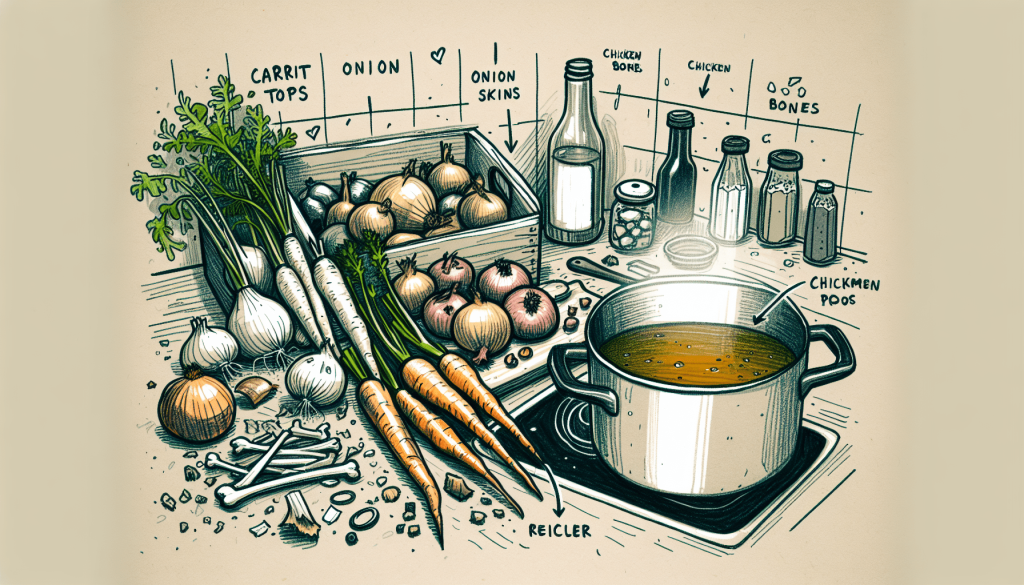Are you tired of throwing away food scraps and bones? Don’t let them go to waste! In this article, you will discover a simple and easy method to make homemade stock from those seemingly useless leftovers. By following a few steps, you will be able to transform scraps and bones into a rich and flavourful stock that can be used as a base for soups, stews, and so much more. Get ready to uncover the secrets of creating delicious homemade stock that will elevate your cooking to a whole new level.
Equipment Needed
To make homemade stock from scraps and bones, you’ll need a few essential pieces of kitchen equipment. First, you’ll need a large stock pot that can accommodate a substantial amount of liquid and ingredients. This is where you’ll be simmering your stock for several hours, so make sure it is a sturdy pot that can withstand prolonged heat.
Next, you’ll need a strainer or colander to remove solids from the liquid once your stock is cooked. This will ensure that you end up with a clear and clean stock. Additionally, a cheesecloth or fine mesh strainer can be useful if you want to strain your stock even further to remove smaller particles.
Lastly, you’ll need storage containers to store your homemade stock. These can be any airtight containers that are suitable for freezing or refrigerating. Make sure they are clean and sterilized before transferring your stock into them.
Ingredients
The ingredients for homemade stock are relatively simple, and most of them can be found in your kitchen or easily purchased at a grocery store. The key components of homemade stock are the scraps and bones from vegetables, meat, or poultry. These can include things like onion skins, carrot ends, celery leaves, and chicken bones.
In addition to the scraps and bones, you’ll need filtered water to create the base of your stock. This will ensure that there are no impurities or contaminants in your final product. Aromatics such as onions, carrots, and celery can also be added to enhance the flavor of your stock. Lastly, don’t forget to include herbs and spices to further enhance the taste of your homemade stock.

Preparing the Scraps and Bones
To start making your homemade stock, it’s essential to collect and store vegetable scraps and save bones from cooked poultry or meat. Whenever you cook, keep a separate container in your kitchen to collect vegetable scraps like onion peels, carrot tops, and celery leaves. These scraps can be stored in the refrigerator or freezer until you have enough to make stock.
Similarly, when you have leftover cooked poultry or meat, make sure to save the bones. Remove any excess meat from the bones as it can be used for other dishes. Storing these bones in a separate bag or container in the freezer is a great way to accumulate the necessary ingredients for your homemade stock.
Choosing Your Vegetables
When it comes to choosing the right vegetables for your homemade stock, a few key players are commonly used. Onions, carrots, celery, garlic, and mushrooms are all excellent options that add depth and flavor to your stock.
Onions provide a sweet and savory taste, while carrots contribute a natural sweetness and vibrant color. Celery adds a fresh and herbaceous note, while garlic brings its unique pungency and robust flavor. Mushrooms, particularly varieties like shiitake or porcini, add a rich and earthy taste to your stock. Feel free to experiment with the ratios of each vegetable to find the blend that suits your taste.

Creating Layers of Flavors
To achieve a flavorful and well-rounded homemade stock, it’s crucial to create layers of flavors during the cooking process. One way to do this is by sautéing the aromatics. Heat a little oil in your stock pot and add the chopped onions, carrots, celery, and garlic. Sauté them until they become fragrant and slightly caramelized, as this will help release their flavors.
Once your aromatics are sautéed, it’s time to add the vegetable scraps and bones. This combination of ingredients will form the base of your stock. Don’t forget to add a selection of herbs and spices to enhance the overall taste. Popular choices include bay leaves, thyme, parsley, black peppercorns, and a pinch of salt. These ingredients will infuse your stock with additional depth and complexity.
The Stock-Making Process
Now that you have all your ingredients prepared, it’s time to start the stock-making process. Begin by covering the ingredients with filtered water in your stock pot. The water should be enough to fully submerge everything but leave some room for simmering, so the pot doesn’t overflow.
Once everything is submerged, bring the water to a boil, then reduce the heat to low and let it simmer. Simmering is the key to extracting the flavors from the ingredients over time. Be sure to skim off any impurities that rise to the surface during the simmering process. This will help ensure that your stock remains clear and clean.
Cook your stock for at least 2-3 hours to allow the flavors to develop fully. During this time, the water will reduce, and the ingredients will break down, resulting in a concentrated and flavor-packed stock.
Once your stock has simmered for the desired time, it’s time to strain it. Using a strainer or colander, carefully separate the liquid from the solids. For a clearer stock, you can strain it again using a cheesecloth or fine mesh strainer to remove any remaining bits. This will give you a smooth and refined homemade stock.
Storing and Freezing Stock
After straining your homemade stock, it’s essential to store it properly to maintain its freshness and quality. Start by allowing the stock to cool completely before transferring it to storage containers. This prevents condensation, which can lead to freezer burn or spoilage.
Divide your stock into smaller portions in airtight storage containers. This way, you can use only what you need for a particular recipe without having to defrost the entire batch. Don’t forget to label and date your containers, so you know when they were made and how long they’ve been stored.
You have two options when it comes to preserving your homemade stock: refrigerating or freezing. If you plan to use the stock within a few days, storing it in the refrigerator is a great option. However, if you want to keep the stock for an extended period, freezing is the way to go. Freezing maintains the freshness and prevents bacteria growth, allowing you to enjoy your homemade stock for months to come.
Creative Uses for Homemade Stock
Homemade stock is a versatile ingredient that can elevate a wide range of dishes. Here are some creative ways to incorporate your stock into your cooking:
Soups and Stews:
Homemade stock is the foundation for flavorful and comforting soups and stews. Whether you’re making a hearty chicken noodle soup or a comforting beef stew, using your homemade stock will add depth and richness to your dish.
Sauces and Gravies:
Stock is the secret ingredient in many sauces and gravies, providing a rich and flavorful base. From classic pan sauces to creamy mushroom gravies, homemade stock will take your sauces to the next level.
Risotto or Rice Dishes:
When cooking risotto or other rice dishes, replace the water with homemade stock. This simple substitution adds layers of flavor and complexity to the dish, making it even more delicious.
Braising Meats and Vegetables:
Braising is a cooking technique that involves searing food and then simmering it in liquid until tender. Homemade stock is an excellent braising liquid, infusing your meats and vegetables with flavor and keeping them moist and succulent.
Tips and Tricks
Here are a few tips and tricks to keep in mind when making homemade stock:
Don’t salt the stock during cooking:
By not adding salt while making the stock, you have the flexibility to control the saltiness when using it in your recipes. This way, you can adjust the seasoning according to the specific dish you’re making.
Label and date your containers:
To avoid confusion, always label your containers with the date the stock was made. This way, you can keep track of how long it has been stored and when it should be used by.
Use ice cube trays for small portions:
If you want to have smaller portions of homemade stock readily available, consider freezing it in ice cube trays. Once frozen, transfer the stock cubes into a freezer bag for easy access. This way, you can easily thaw just the amount you need for a quick sauce or seasoning.
Reuse vegetable scraps for composting:
After making your stock, don’t let those vegetable scraps go to waste. Instead, consider composting them. Vegetable scraps are a great addition to compost piles or bins, enriching the soil and reducing food waste.
Conclusion
Homemade stock is a simple yet powerful ingredient that can enhance the flavors of your dishes. By repurposing scraps and bones that would otherwise go to waste, you can create a versatile and flavorful stock in your own kitchen. Whether you use it in soups, sauces, or rice dishes, homemade stock adds depth and richness to your culinary creations. So next time you cook, don’t throw away those scraps and bones – turn them into delicious homemade stock!
